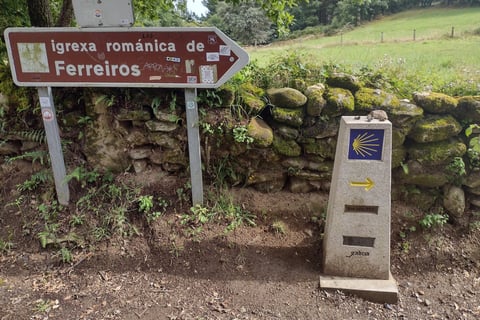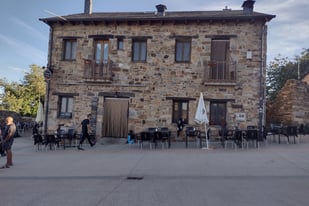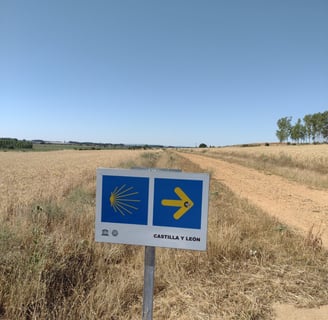Common Questions About Walking the Camino: A Beginner's Guide
If you've ever thought about walking the Camino de Santiago, take a quick read through these common questions and answers to get you excited about walking it someday!
Mario Picoas
4/12/20256 min read


What is the Camino de Santiago?
The Camino de Santiago, or "The Way of Saint James," ends at the Cathedral of Santiago de Compostela in Spain which is located in Northwest of the country. Those who walk it are called "peregrinos" (pilgrims) and these peregrinos have been making their way to Santiago since the 9th century, when the remains of Saint James the Apostle were supposedly found in that area. Since that time, the Camino has garnered interest not only as a religious pilgrimage, but also as an experience appealing to people walking for a variety of reasons, both spiritual and adventure travel.
There are many different ways to get to Santiago de Compostela. They say that the Camino starts at your front door even if that means you need to fly to get Spain to begin the walking portion of your Camino. There are several well-known routes, namely: the French Way, the Portuguese Way, and others, which all have their special charm. The landscape is vastly varied, with everything from rolling hills and sleepy villages to busy city centers, encapsulating the vastness and beauty of Spain and Northern Portugal. A variable landscape is part of the reason why thousands of pilgrims make the journey down these famous routes.
Walking (or cycling) the Camino is done for a variety of reasons. Some do it for a spiritual journey and reflect and contemplate life while walking in nature. Others walk the Camino for an adventure and to challenge their body and spirit's endurance. The Camino is growing in popularity for purposes of spirituality and as part of a community of walkers who build friendships along the way. Ultimately, the experience can be personal, and each pilgrim walks to achieve a different meaning from the journey.
What should I pack for my Camino journey?
Careful consideration of the essential items for your Camino trip is important when packing for your adventure. Number one on your list should be the right backpack. You'll want to purchase a backpack that is both lightweight and ergonomic; ideally, it should be 40-70 liters capacity so that you can pack all your gear and not feel overburdened. In regards to your clothing- it is best to choose moisture-wicking fabrics that help with sweat management and added comfort in different weather encounters. A viable layering system is recommended, including a base layer, an insulating layer, and a waterproof outer layer to adapt to the different climates you may experience. Best advice: be prepared but pack lightly!
Footwear is another part of your packing strategy that’s of great importance. Make sure you have lightweight, well-fitting hiking shoes or boots that provide enough support and traction to keep your feet safe on the trail. It’s a good idea to break in your footwear prior to your trip. This will lessen the possibility of blistering and discomfort during travel. Don’t forget a number of pairs of moisture-wicking socks since changing your socks regularly makes a difference in foot-friendly hygiene.
It is also important to have a simple first-aid kit for any injuries or discomfort that may arise. In this kit, you would want to carry blister pads, adhesive band-aids, antiseptic wipes for skin cleaning, and pain relief medication. For hydration, make sure you have a reusable water bottle or a hydration bladder to make it easy to hydrate as you walk. You may want to consider also carrying a lightweight sleeping bag, portable charger for electronics, and basic cooking utensils if you want to prepare food.
It is good to have in mind the benefits of packing light. A heavy backpack means tiredness and distracts from the spiritual journey of walking the Camino. Your goal should be to keep your total pack weight at under 10% of your body weight. If you carefully design your packing list, you are not only being kind to your body, but also allowing yourself to experience greater enjoyment of the journey ahead on this amazing pilgrimage.
How fit do I need to be to walk the Camino?
Walking the Camino can be an incredible experience, and many potential pilgrims ask themselves what level of fitness is needed for the journey. Each day you walk brings new experiences and differences in terrain, altitude services available and of course the weather! Some days you may experience cool to cold mornings, mist, drizzle, rain or blasting sunshine--even in the same day and even in summer! Usually, walking the Camino de Santiago does not require someone to be a top level athlete, but a reasonable level of fitness will enhance the experience and create a capable adventure. Some time spent hiking in your local area with a backpack on will definitely help you get an idea of what it will be like. Keep in mind: pilgrims often walk on average 5-8 hours a day! So you'll want to get some practice before you set off.
For the more traveled routes, like the Camino Francés, a moderate level of fitness should be more than sufficient. Like it was just mentioned, pilgrims should be able to comfortably walk at least 10 to 15 km (6 to 9 miles) each day (however many walk much more), and should have a training program in place for at least several months prior to departure. This may include walking, hiking, or some other aerobic activity on a regular basis to build up endurance. Strength training for the legs and core through stability exercises can also help, considering prolonged walking will put stress on these areas.
Furthermore, it is important to be mindful of your stamina and injury prevention throughout the journey. Hikers should slowly increase their distance walked daily, practice walking with similar terrain as that of the Camino, and take care regarding shoe choice. Shoes are critical. Make sure your shoes will be "broken-in" prior to embarking on the hike to prevent blisters or discomfort. Utilizing rest days and nutrition on the trail also helps with recovery and sustaining energy on an extended journey.
To sum up, a diverse range of fitness levels can participate in the Camino, but with adequate preparation and a focus on building endurance, your pilgrimage will be enhanced. With the right approach and training, walkers of all fitness levels can benefit from the profoundness of the experience of the Camino.
What are the accommodations like along the Camino?
The Camino de Santiago offers a unique opportunity to experience many different kinds of lodging that suit every pilgrim's needs and desired comfort. You can find lodging options along the way that range from basic, public albergues (inns) to very nice hotels. Albergues are generally hostels specifically for pilgrims offering shared dorm-style rooms in a communal atmosphere for guests that stay and interact there. Albergues charge a small fee, with many locations providing a built-in shared shower, kitchen, and living space that share communication and social experience.
Lodgings along the Camino are available for those looking for more privacy and comfort. Hotels and lodgings are predominantly able to offer single accommodation, most of which have en-suite accommodation and dining areas. The hotel rates along the Camino will vary greatly depending on the specific hotel as well as where it is located, and prices will generally advance during peak months of transition (including the late spring and summer). It is typically advisable to book lodgings in advance during these high-volume months to guarantee accommodations, as a lot of the hotels and lodgings will fill up quickly.
For the adventurous pilgrim who is looking for a more economical option, there are campsites. Although campsites don’t generally offer the same amenities as albergues or hotels, they give travelers a chance to be in nature and can even be located near towns or villages along the way. Regardless of where a pilgrim may choose to stay, there are special challenges for pilgrims that may be due to the accommodations themselves, especially during the busier season. So, flexible plans and a mindset of rejection by shortage can only improve the walking experience.
In general, the variety of places to stay on the Camino can serve each kind of traveler, allowing each pilgrim to carve their own distinct journey while still embracing the richness of shared housing arrangements and shared experiences.










